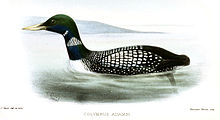Yellow-billed loon
| Yellow-billed loon | |
|---|---|

| |
| Scientific classification | |
| Domain: | Eukaryota |
| Kingdom: | Animalia |
| Phylum: | Chordata |
| Class: | Aves |
| Order: | Gaviiformes |
| Family: | Gaviidae |
| Genus: | Gavia |
| Species: | G. adamsii
|
| Binomial name | |
| Gavia adamsii (Gray, 1859)
| |

| |
| Range of G. adamsii Breeding range Wintering range
| |
The yellow-billed loon (Gavia adamsii), also known as the white-billed diver, is the largest member of the
It breeds in the
Taxonomy and etymology

First described by English zoologist
The genus name Gavia comes from the
Description

With a length of 76 to 97 cm (30 to 38 in), a wingspan of 135 to 160 cm (53 to 63 in), and a weight ranging from 4 to 6.4 kg (8.8 to 14.1 lb), the yellow-billed loon is the largest member of the loon (diver) family.[2][7][8] The adult is primarily black and white in breeding plumage, with a purple gloss on its head and neck.[9]
Habitat and range
The yellow-billed loon is an Arctic species, breeding primarily along the coasts of the Arctic Ocean as far north as 78° N and wintering on sheltered coastal waters of the northern Pacific Ocean and the northwestern coast of Norway.[2] It has been recorded as a breeding bird in Russia, Canada and the United States.[1] Though it winters primarily to the north of 50° N, its winter range extends south to 35° N off the coast of Japan,[2] and it has been recorded as a vagrant in more than 20 countries,[1] including some as far south as Mexico[10] and Spain.[1]
Behaviour
Breeding
Like other loons, it forms long-lasting pairs. Though it prefers freshwater pools or lakes in the tundra, the yellow-billed loon will also breed along rivers, estuaries or the coast in low-lying areas of the Arctic; in general, it avoids forested areas. Breeding typically starts in early June, though it is dependent on the timing of the spring thaw. Like all members of its family, the yellow-billed loon builds a nest of plant material very close to the edge of the water. Copulation takes place on land, without any specific courtship. The pair defends its large territory intensively against intruders, but may later in the breeding season gang up with other birds on good fishing spots.[2]
The female lays two eggs measuring 89 by 55 millimetres (3.5 by 2.2 in). The eggs are strongly oval, and are a light purple-brown with darker blotches interspersed. This colour camouflages with the soil and vegetation that this bird nests near. Most of the time, however, the egg is not visible due to incubation, which takes around 27 to 29 days.[11]
Feeding
The yellow-billed loon is a specialist fish eater, yet it also takes
Conservation and threats
In 2010, the
The yellow-billed loon is one of the species to which the Agreement on the Conservation of African-Eurasian Migratory Waterbirds (AEWA) applies;[12] in the Americas, it is protected by the Migratory Bird Treaty Act of 1918.[13]
The yellow-billed loon is especially vulnerable because of its low fecundity, and face many threats related to their habitat. They need to live in areas with large, deep lakes and these environments are threatened due to high rates of human interaction, such as oil drilling, and the warming climate of their natural habitats. They often nest near oil drilling equipment posing a litany of issues regarding injury and exposure to crude oil. The warming climate causes them to leave their nests in search of cooler areas, leaving their nests, eggs, and young exposed to predation. They are also very territorial birds, and often face injuries that can result in death from fighting other organisms. [14]
References
Citations
- ^ . Retrieved 12 November 2021.
- ^ a b c d e f g Carboneras 1992, p. 172.
- ^ Carboneras 1992, p. 162.
- ^ Johnsgard, Paul A. (1987). "Diving Birds of North America: Appendices". University of Nebraska, Lincoln. p. 265. Retrieved 6 March 2010.
- ^ ISBN 0-88192-600-0.
- ^ Carboneras 1992, p. 169.
- ^ "Yellow-billed Loon". eNature.com. 2011. Archived from the original on 16 January 2010.
- ISBN 978-0-8493-4258-5.
- ^ Cramp 1977, p. 62
- ISBN 0-19-854012-4.
- ^ ISBN 978-0-226-05781-1.
- ^ "Waterbird species to which the Agreement applies" (PDF). Agreement on the Conservation of African-Eurasian Migratory Waterbirds. p. 22. Retrieved 18 December 2014.
- US Fish and Wildlife Service. Retrieved 6 March 2011.
- ^ Perrett, Julie. "Factors Influencing Incubation Behavior and Nesting Success of Yellow-Billed Loons in Arctic Alaska". Wildlife.onlinelibrary.wiley.com. The Journal of Wildlife Mangement. Retrieved 15 March 2024.
Bibliography
Sjölander, Sverre. The reproductive Behavior of the Yellow-billed Loon, Gavia adamsii. (With G. Ågren). The Condor 78:454-463. 1976.
Further reading
- Carboneras, Carles (1992). "Family Gaviidae (Divers)". In del Hoyo, Josep; Elliott, Andrew; Sargatal, Jordi (eds.). Handbook of the Birds of the World. Vol. 1: Ostrich to Ducks. Barcelona: Lynx Edicions. pp. 162–172. ISBN 84-87334-10-5.
- Cramp, Stanley, ed. (1977). "Gavia adamsii White-billed Diver". Handbook of the Birds of Europe, the Middle East and North Africa: ISBN 0-19-857358-8.
- Sjölander, Sverre; Ågren, Greta (1976). "The reproductive Behavior of the Yellow-billed Loon, Gavia adamsii". The Condor. 78 (4): 454–463. JSTOR 1367094.
Identification
- Appleby, R.H.; Madge, S.C.; Mullarney, Killian (1986). "Identification of divers in immature and winter plumages". British Birds. 79 (8): 365–391.
External links
- Flicker Field Guide Birds of the World Photographs
- BirdLife species factsheet for Gavia adamsii
- "Gavia adamsii". Avibase.
- "White-billed diver media". Internet Bird Collection.
- Yellow-billed loon photo gallery at VIREO (Drexel University)
- Audio recordings of Yellow-billed loon on Xeno-canto.

